Lesson Planning and HRM Practices: Delivering Inclusive Teaching
VerifiedAdded on 2023/06/14
|18
|5570
|61
Essay
AI Summary
This essay provides a comprehensive overview of lesson planning and its integration with Human Resource Management (HRM) practices. It begins by explaining the aims and characteristics of effective lesson planning, emphasizing the importance of aligning with learners' goals and needs. The essay analyzes learning styles and taxonomies, particularly Bloom's Taxonomy and the VARK model, to enhance lesson design. It further discusses strategies for ensuring inclusivity in lesson plans, focusing on learning environments and risk assessment. The preparation of effective lesson plans, including outlining objectives, specific activities, and timelines, is detailed. The importance of flexibility and adaptability in lesson plan design is highlighted, along with an analysis of how lesson plan design affects the delivery of inclusive teaching and learning. An exemplar lesson plan on HRM practices is included, followed by a discussion of assessment and evaluation methods, differentiated assessments, and the use of assessment results to inform lesson planning. The essay concludes by underscoring the significance of well-designed and adaptable lesson plans in achieving effective and inclusive teaching and learning outcomes.
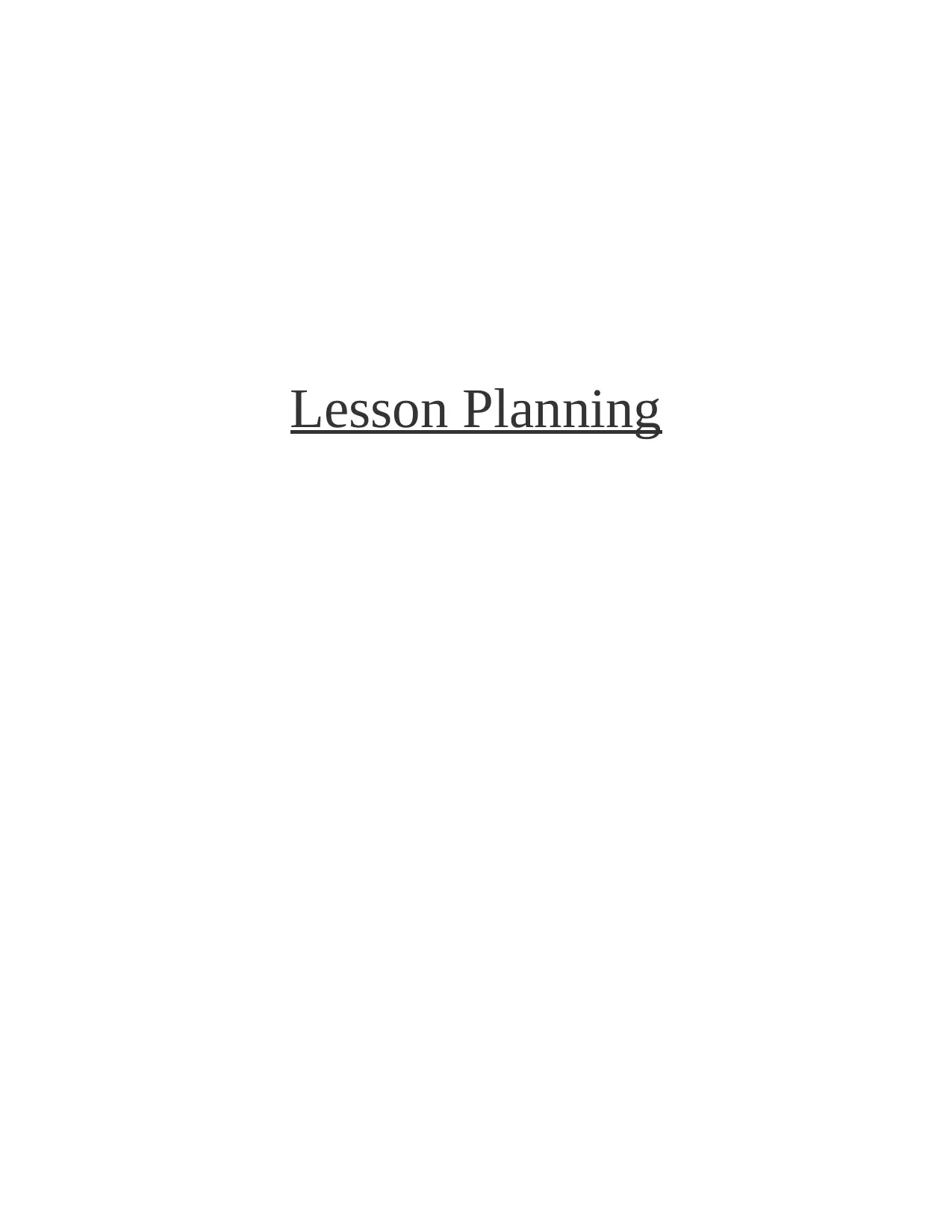
Lesson Planning
Paraphrase This Document
Need a fresh take? Get an instant paraphrase of this document with our AI Paraphraser
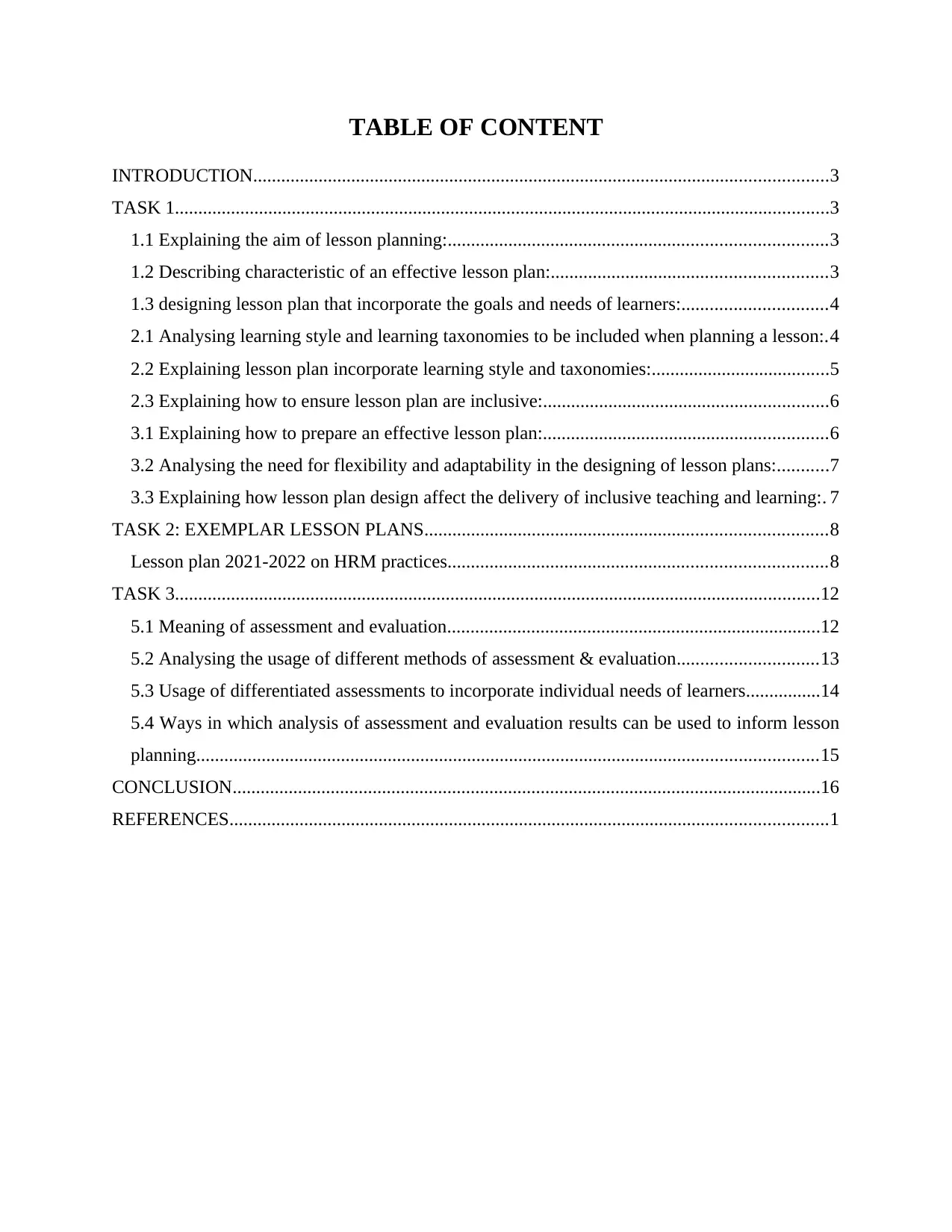
TABLE OF CONTENT
INTRODUCTION...........................................................................................................................3
TASK 1............................................................................................................................................3
1.1 Explaining the aim of lesson planning:.................................................................................3
1.2 Describing characteristic of an effective lesson plan:...........................................................3
1.3 designing lesson plan that incorporate the goals and needs of learners:...............................4
2.1 Analysing learning style and learning taxonomies to be included when planning a lesson:.4
2.2 Explaining lesson plan incorporate learning style and taxonomies:......................................5
2.3 Explaining how to ensure lesson plan are inclusive:.............................................................6
3.1 Explaining how to prepare an effective lesson plan:.............................................................6
3.2 Analysing the need for flexibility and adaptability in the designing of lesson plans:...........7
3.3 Explaining how lesson plan design affect the delivery of inclusive teaching and learning:. 7
TASK 2: EXEMPLAR LESSON PLANS......................................................................................8
Lesson plan 2021-2022 on HRM practices.................................................................................8
TASK 3..........................................................................................................................................12
5.1 Meaning of assessment and evaluation................................................................................12
5.2 Analysing the usage of different methods of assessment & evaluation..............................13
5.3 Usage of differentiated assessments to incorporate individual needs of learners................14
5.4 Ways in which analysis of assessment and evaluation results can be used to inform lesson
planning.....................................................................................................................................15
CONCLUSION..............................................................................................................................16
REFERENCES................................................................................................................................1
INTRODUCTION...........................................................................................................................3
TASK 1............................................................................................................................................3
1.1 Explaining the aim of lesson planning:.................................................................................3
1.2 Describing characteristic of an effective lesson plan:...........................................................3
1.3 designing lesson plan that incorporate the goals and needs of learners:...............................4
2.1 Analysing learning style and learning taxonomies to be included when planning a lesson:.4
2.2 Explaining lesson plan incorporate learning style and taxonomies:......................................5
2.3 Explaining how to ensure lesson plan are inclusive:.............................................................6
3.1 Explaining how to prepare an effective lesson plan:.............................................................6
3.2 Analysing the need for flexibility and adaptability in the designing of lesson plans:...........7
3.3 Explaining how lesson plan design affect the delivery of inclusive teaching and learning:. 7
TASK 2: EXEMPLAR LESSON PLANS......................................................................................8
Lesson plan 2021-2022 on HRM practices.................................................................................8
TASK 3..........................................................................................................................................12
5.1 Meaning of assessment and evaluation................................................................................12
5.2 Analysing the usage of different methods of assessment & evaluation..............................13
5.3 Usage of differentiated assessments to incorporate individual needs of learners................14
5.4 Ways in which analysis of assessment and evaluation results can be used to inform lesson
planning.....................................................................................................................................15
CONCLUSION..............................................................................................................................16
REFERENCES................................................................................................................................1
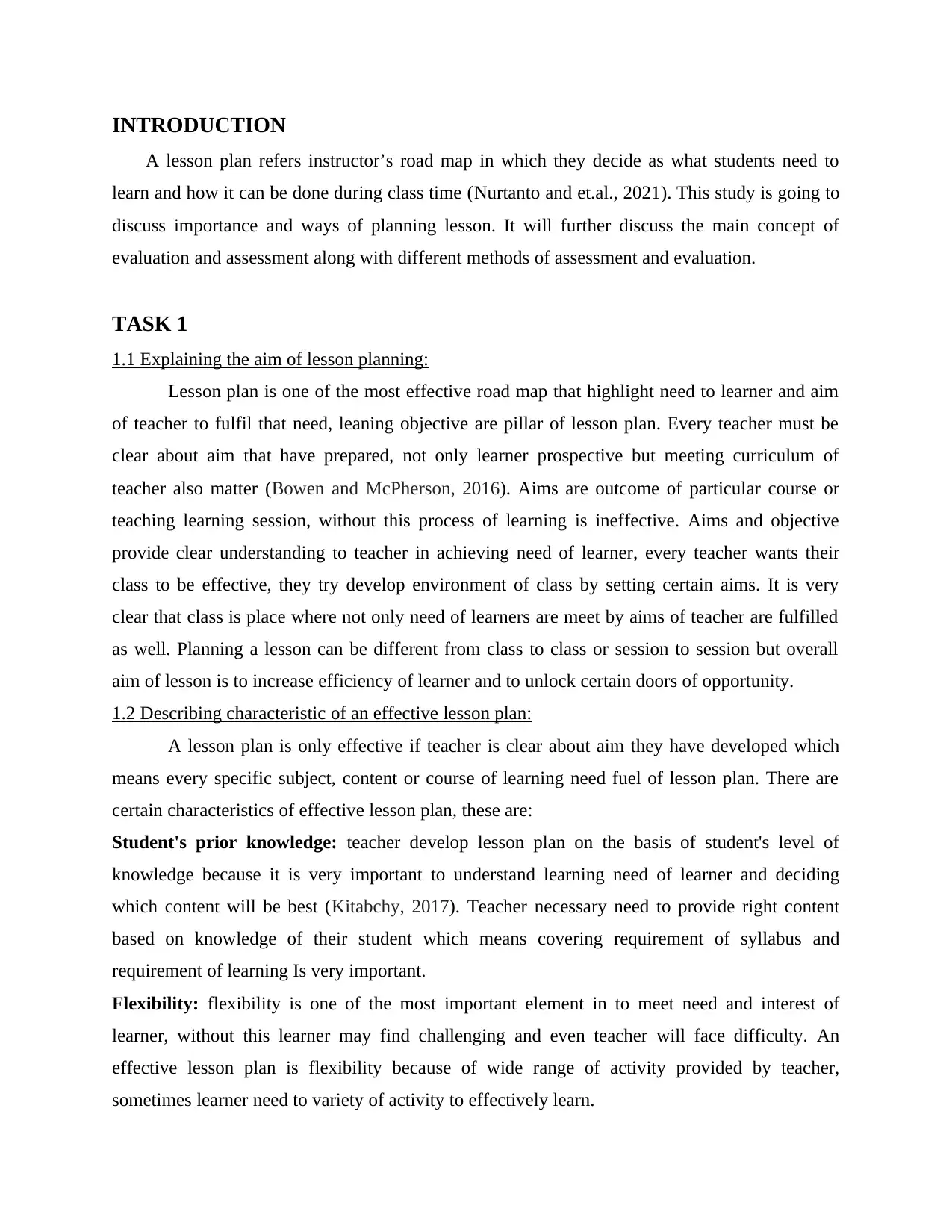
INTRODUCTION
A lesson plan refers instructor’s road map in which they decide as what students need to
learn and how it can be done during class time (Nurtanto and et.al., 2021). This study is going to
discuss importance and ways of planning lesson. It will further discuss the main concept of
evaluation and assessment along with different methods of assessment and evaluation.
TASK 1
1.1 Explaining the aim of lesson planning:
Lesson plan is one of the most effective road map that highlight need to learner and aim
of teacher to fulfil that need, leaning objective are pillar of lesson plan. Every teacher must be
clear about aim that have prepared, not only learner prospective but meeting curriculum of
teacher also matter (Bowen and McPherson, 2016). Aims are outcome of particular course or
teaching learning session, without this process of learning is ineffective. Aims and objective
provide clear understanding to teacher in achieving need of learner, every teacher wants their
class to be effective, they try develop environment of class by setting certain aims. It is very
clear that class is place where not only need of learners are meet by aims of teacher are fulfilled
as well. Planning a lesson can be different from class to class or session to session but overall
aim of lesson is to increase efficiency of learner and to unlock certain doors of opportunity.
1.2 Describing characteristic of an effective lesson plan:
A lesson plan is only effective if teacher is clear about aim they have developed which
means every specific subject, content or course of learning need fuel of lesson plan. There are
certain characteristics of effective lesson plan, these are:
Student's prior knowledge: teacher develop lesson plan on the basis of student's level of
knowledge because it is very important to understand learning need of learner and deciding
which content will be best (Kitabchy, 2017). Teacher necessary need to provide right content
based on knowledge of their student which means covering requirement of syllabus and
requirement of learning Is very important.
Flexibility: flexibility is one of the most important element in to meet need and interest of
learner, without this learner may find challenging and even teacher will face difficulty. An
effective lesson plan is flexibility because of wide range of activity provided by teacher,
sometimes learner need to variety of activity to effectively learn.
A lesson plan refers instructor’s road map in which they decide as what students need to
learn and how it can be done during class time (Nurtanto and et.al., 2021). This study is going to
discuss importance and ways of planning lesson. It will further discuss the main concept of
evaluation and assessment along with different methods of assessment and evaluation.
TASK 1
1.1 Explaining the aim of lesson planning:
Lesson plan is one of the most effective road map that highlight need to learner and aim
of teacher to fulfil that need, leaning objective are pillar of lesson plan. Every teacher must be
clear about aim that have prepared, not only learner prospective but meeting curriculum of
teacher also matter (Bowen and McPherson, 2016). Aims are outcome of particular course or
teaching learning session, without this process of learning is ineffective. Aims and objective
provide clear understanding to teacher in achieving need of learner, every teacher wants their
class to be effective, they try develop environment of class by setting certain aims. It is very
clear that class is place where not only need of learners are meet by aims of teacher are fulfilled
as well. Planning a lesson can be different from class to class or session to session but overall
aim of lesson is to increase efficiency of learner and to unlock certain doors of opportunity.
1.2 Describing characteristic of an effective lesson plan:
A lesson plan is only effective if teacher is clear about aim they have developed which
means every specific subject, content or course of learning need fuel of lesson plan. There are
certain characteristics of effective lesson plan, these are:
Student's prior knowledge: teacher develop lesson plan on the basis of student's level of
knowledge because it is very important to understand learning need of learner and deciding
which content will be best (Kitabchy, 2017). Teacher necessary need to provide right content
based on knowledge of their student which means covering requirement of syllabus and
requirement of learning Is very important.
Flexibility: flexibility is one of the most important element in to meet need and interest of
learner, without this learner may find challenging and even teacher will face difficulty. An
effective lesson plan is flexibility because of wide range of activity provided by teacher,
sometimes learner need to variety of activity to effectively learn.
⊘ This is a preview!⊘
Do you want full access?
Subscribe today to unlock all pages.

Trusted by 1+ million students worldwide
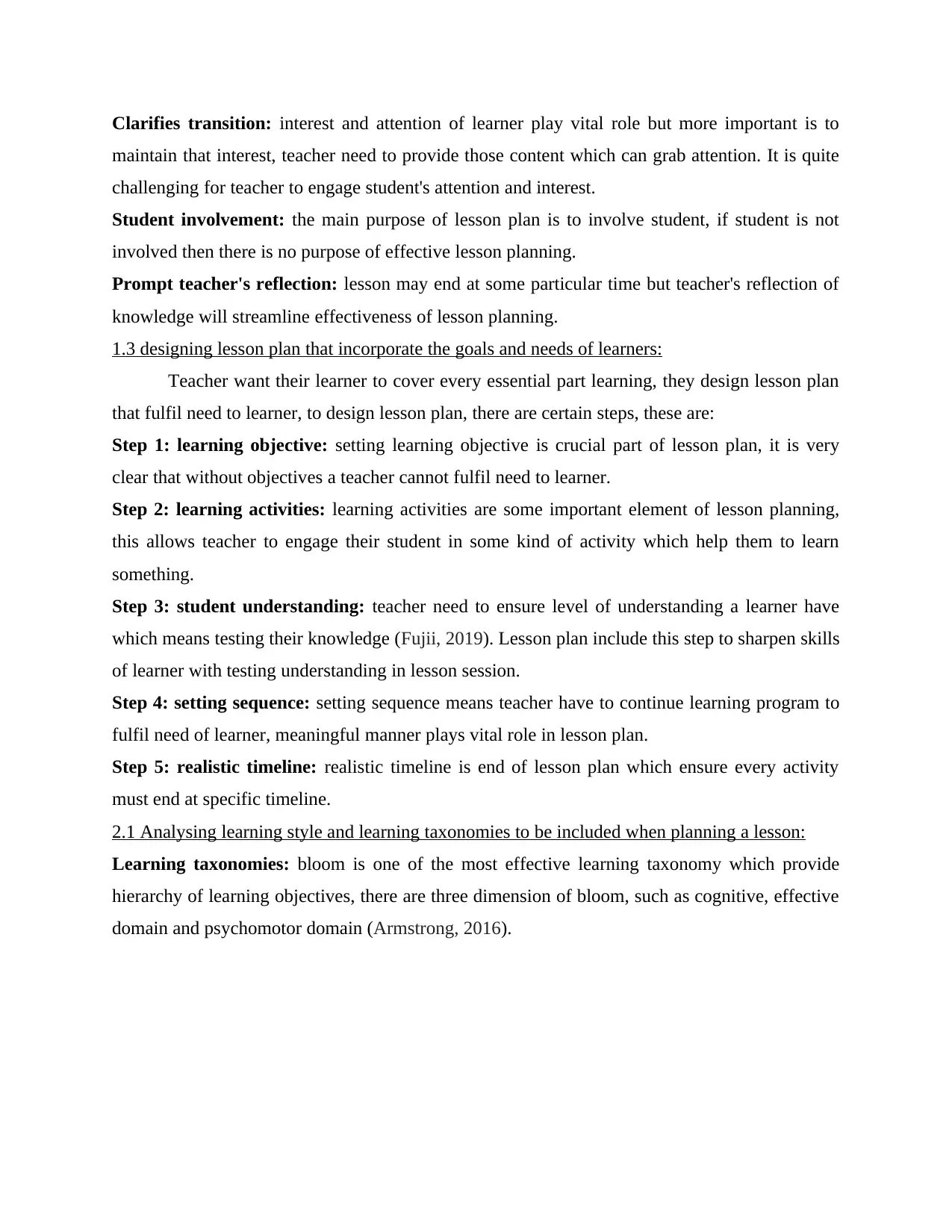
Clarifies transition: interest and attention of learner play vital role but more important is to
maintain that interest, teacher need to provide those content which can grab attention. It is quite
challenging for teacher to engage student's attention and interest.
Student involvement: the main purpose of lesson plan is to involve student, if student is not
involved then there is no purpose of effective lesson planning.
Prompt teacher's reflection: lesson may end at some particular time but teacher's reflection of
knowledge will streamline effectiveness of lesson planning.
1.3 designing lesson plan that incorporate the goals and needs of learners:
Teacher want their learner to cover every essential part learning, they design lesson plan
that fulfil need to learner, to design lesson plan, there are certain steps, these are:
Step 1: learning objective: setting learning objective is crucial part of lesson plan, it is very
clear that without objectives a teacher cannot fulfil need to learner.
Step 2: learning activities: learning activities are some important element of lesson planning,
this allows teacher to engage their student in some kind of activity which help them to learn
something.
Step 3: student understanding: teacher need to ensure level of understanding a learner have
which means testing their knowledge (Fujii, 2019). Lesson plan include this step to sharpen skills
of learner with testing understanding in lesson session.
Step 4: setting sequence: setting sequence means teacher have to continue learning program to
fulfil need of learner, meaningful manner plays vital role in lesson plan.
Step 5: realistic timeline: realistic timeline is end of lesson plan which ensure every activity
must end at specific timeline.
2.1 Analysing learning style and learning taxonomies to be included when planning a lesson:
Learning taxonomies: bloom is one of the most effective learning taxonomy which provide
hierarchy of learning objectives, there are three dimension of bloom, such as cognitive, effective
domain and psychomotor domain (Armstrong, 2016).
maintain that interest, teacher need to provide those content which can grab attention. It is quite
challenging for teacher to engage student's attention and interest.
Student involvement: the main purpose of lesson plan is to involve student, if student is not
involved then there is no purpose of effective lesson planning.
Prompt teacher's reflection: lesson may end at some particular time but teacher's reflection of
knowledge will streamline effectiveness of lesson planning.
1.3 designing lesson plan that incorporate the goals and needs of learners:
Teacher want their learner to cover every essential part learning, they design lesson plan
that fulfil need to learner, to design lesson plan, there are certain steps, these are:
Step 1: learning objective: setting learning objective is crucial part of lesson plan, it is very
clear that without objectives a teacher cannot fulfil need to learner.
Step 2: learning activities: learning activities are some important element of lesson planning,
this allows teacher to engage their student in some kind of activity which help them to learn
something.
Step 3: student understanding: teacher need to ensure level of understanding a learner have
which means testing their knowledge (Fujii, 2019). Lesson plan include this step to sharpen skills
of learner with testing understanding in lesson session.
Step 4: setting sequence: setting sequence means teacher have to continue learning program to
fulfil need of learner, meaningful manner plays vital role in lesson plan.
Step 5: realistic timeline: realistic timeline is end of lesson plan which ensure every activity
must end at specific timeline.
2.1 Analysing learning style and learning taxonomies to be included when planning a lesson:
Learning taxonomies: bloom is one of the most effective learning taxonomy which provide
hierarchy of learning objectives, there are three dimension of bloom, such as cognitive, effective
domain and psychomotor domain (Armstrong, 2016).
Paraphrase This Document
Need a fresh take? Get an instant paraphrase of this document with our AI Paraphraser
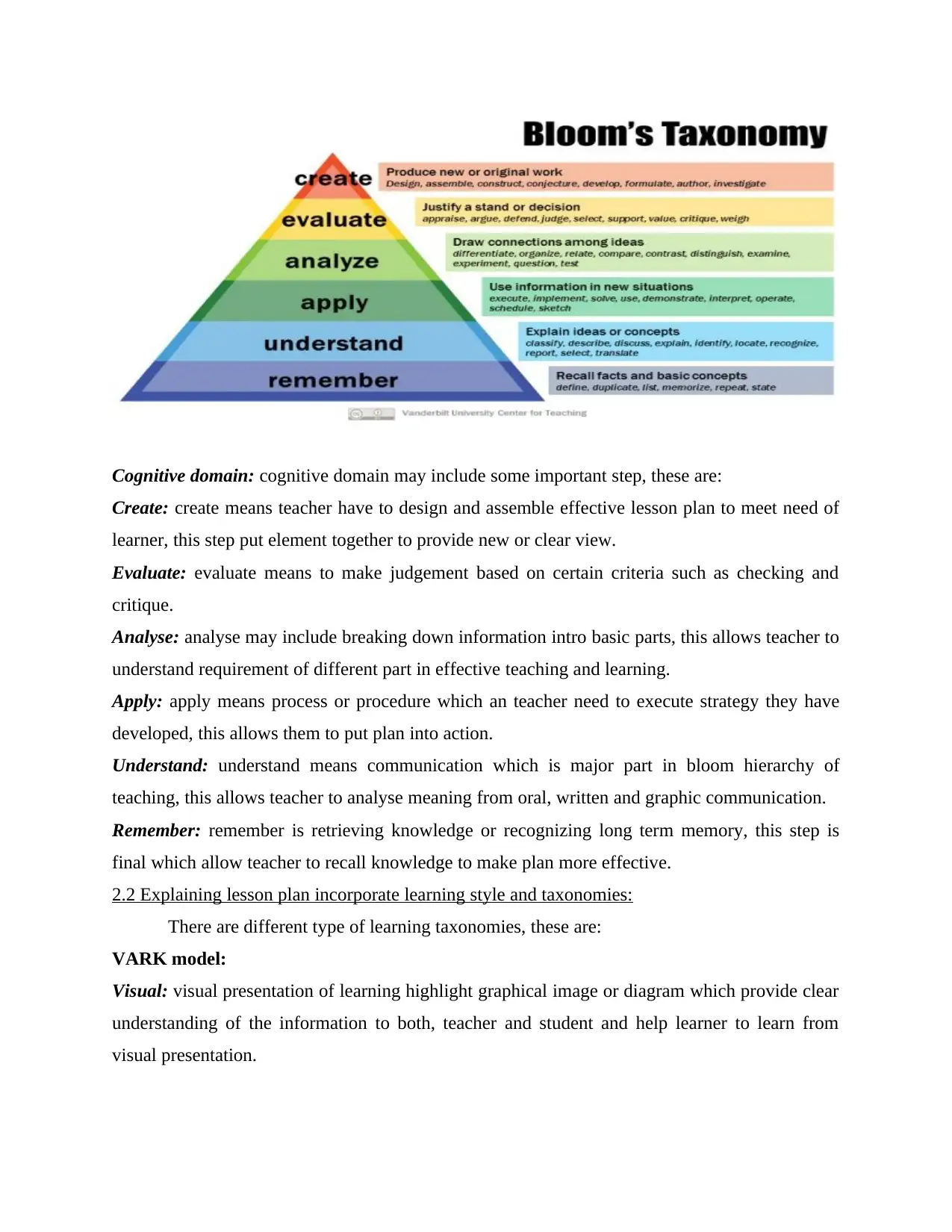
Cognitive domain: cognitive domain may include some important step, these are:
Create: create means teacher have to design and assemble effective lesson plan to meet need of
learner, this step put element together to provide new or clear view.
Evaluate: evaluate means to make judgement based on certain criteria such as checking and
critique.
Analyse: analyse may include breaking down information intro basic parts, this allows teacher to
understand requirement of different part in effective teaching and learning.
Apply: apply means process or procedure which an teacher need to execute strategy they have
developed, this allows them to put plan into action.
Understand: understand means communication which is major part in bloom hierarchy of
teaching, this allows teacher to analyse meaning from oral, written and graphic communication.
Remember: remember is retrieving knowledge or recognizing long term memory, this step is
final which allow teacher to recall knowledge to make plan more effective.
2.2 Explaining lesson plan incorporate learning style and taxonomies:
There are different type of learning taxonomies, these are:
VARK model:
Visual: visual presentation of learning highlight graphical image or diagram which provide clear
understanding of the information to both, teacher and student and help learner to learn from
visual presentation.
Create: create means teacher have to design and assemble effective lesson plan to meet need of
learner, this step put element together to provide new or clear view.
Evaluate: evaluate means to make judgement based on certain criteria such as checking and
critique.
Analyse: analyse may include breaking down information intro basic parts, this allows teacher to
understand requirement of different part in effective teaching and learning.
Apply: apply means process or procedure which an teacher need to execute strategy they have
developed, this allows them to put plan into action.
Understand: understand means communication which is major part in bloom hierarchy of
teaching, this allows teacher to analyse meaning from oral, written and graphic communication.
Remember: remember is retrieving knowledge or recognizing long term memory, this step is
final which allow teacher to recall knowledge to make plan more effective.
2.2 Explaining lesson plan incorporate learning style and taxonomies:
There are different type of learning taxonomies, these are:
VARK model:
Visual: visual presentation of learning highlight graphical image or diagram which provide clear
understanding of the information to both, teacher and student and help learner to learn from
visual presentation.
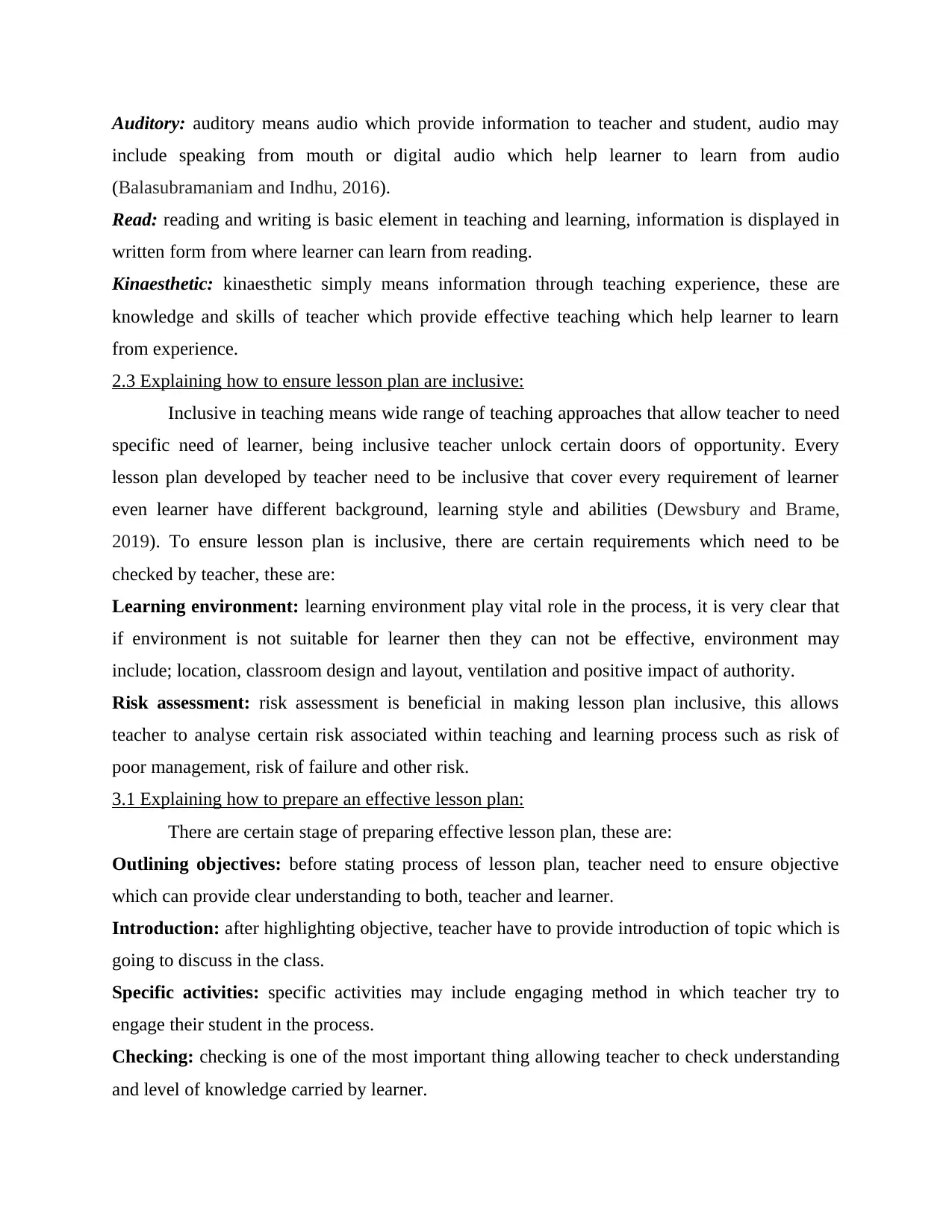
Auditory: auditory means audio which provide information to teacher and student, audio may
include speaking from mouth or digital audio which help learner to learn from audio
(Balasubramaniam and Indhu, 2016).
Read: reading and writing is basic element in teaching and learning, information is displayed in
written form from where learner can learn from reading.
Kinaesthetic: kinaesthetic simply means information through teaching experience, these are
knowledge and skills of teacher which provide effective teaching which help learner to learn
from experience.
2.3 Explaining how to ensure lesson plan are inclusive:
Inclusive in teaching means wide range of teaching approaches that allow teacher to need
specific need of learner, being inclusive teacher unlock certain doors of opportunity. Every
lesson plan developed by teacher need to be inclusive that cover every requirement of learner
even learner have different background, learning style and abilities (Dewsbury and Brame,
2019). To ensure lesson plan is inclusive, there are certain requirements which need to be
checked by teacher, these are:
Learning environment: learning environment play vital role in the process, it is very clear that
if environment is not suitable for learner then they can not be effective, environment may
include; location, classroom design and layout, ventilation and positive impact of authority.
Risk assessment: risk assessment is beneficial in making lesson plan inclusive, this allows
teacher to analyse certain risk associated within teaching and learning process such as risk of
poor management, risk of failure and other risk.
3.1 Explaining how to prepare an effective lesson plan:
There are certain stage of preparing effective lesson plan, these are:
Outlining objectives: before stating process of lesson plan, teacher need to ensure objective
which can provide clear understanding to both, teacher and learner.
Introduction: after highlighting objective, teacher have to provide introduction of topic which is
going to discuss in the class.
Specific activities: specific activities may include engaging method in which teacher try to
engage their student in the process.
Checking: checking is one of the most important thing allowing teacher to check understanding
and level of knowledge carried by learner.
include speaking from mouth or digital audio which help learner to learn from audio
(Balasubramaniam and Indhu, 2016).
Read: reading and writing is basic element in teaching and learning, information is displayed in
written form from where learner can learn from reading.
Kinaesthetic: kinaesthetic simply means information through teaching experience, these are
knowledge and skills of teacher which provide effective teaching which help learner to learn
from experience.
2.3 Explaining how to ensure lesson plan are inclusive:
Inclusive in teaching means wide range of teaching approaches that allow teacher to need
specific need of learner, being inclusive teacher unlock certain doors of opportunity. Every
lesson plan developed by teacher need to be inclusive that cover every requirement of learner
even learner have different background, learning style and abilities (Dewsbury and Brame,
2019). To ensure lesson plan is inclusive, there are certain requirements which need to be
checked by teacher, these are:
Learning environment: learning environment play vital role in the process, it is very clear that
if environment is not suitable for learner then they can not be effective, environment may
include; location, classroom design and layout, ventilation and positive impact of authority.
Risk assessment: risk assessment is beneficial in making lesson plan inclusive, this allows
teacher to analyse certain risk associated within teaching and learning process such as risk of
poor management, risk of failure and other risk.
3.1 Explaining how to prepare an effective lesson plan:
There are certain stage of preparing effective lesson plan, these are:
Outlining objectives: before stating process of lesson plan, teacher need to ensure objective
which can provide clear understanding to both, teacher and learner.
Introduction: after highlighting objective, teacher have to provide introduction of topic which is
going to discuss in the class.
Specific activities: specific activities may include engaging method in which teacher try to
engage their student in the process.
Checking: checking is one of the most important thing allowing teacher to check understanding
and level of knowledge carried by learner.
⊘ This is a preview!⊘
Do you want full access?
Subscribe today to unlock all pages.

Trusted by 1+ million students worldwide
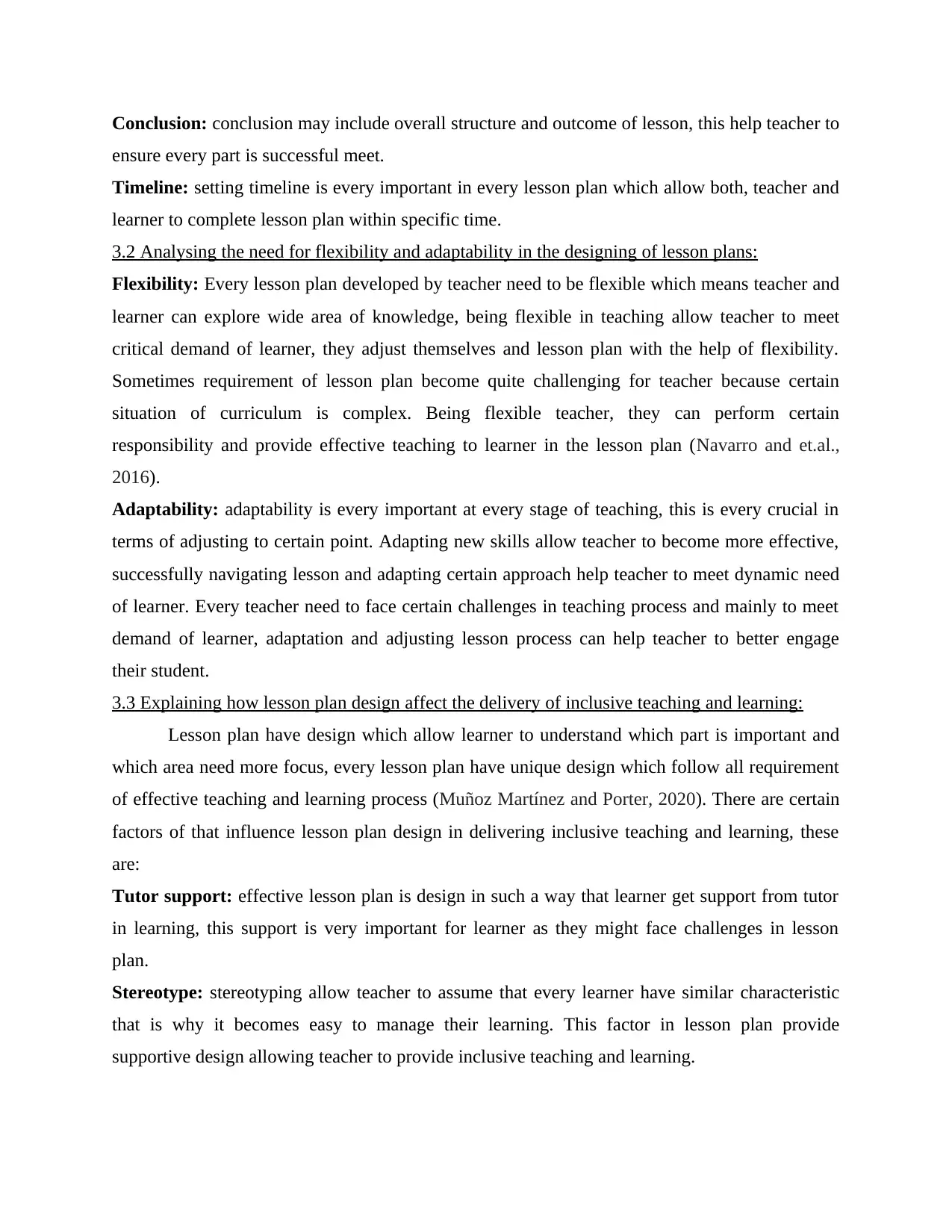
Conclusion: conclusion may include overall structure and outcome of lesson, this help teacher to
ensure every part is successful meet.
Timeline: setting timeline is every important in every lesson plan which allow both, teacher and
learner to complete lesson plan within specific time.
3.2 Analysing the need for flexibility and adaptability in the designing of lesson plans:
Flexibility: Every lesson plan developed by teacher need to be flexible which means teacher and
learner can explore wide area of knowledge, being flexible in teaching allow teacher to meet
critical demand of learner, they adjust themselves and lesson plan with the help of flexibility.
Sometimes requirement of lesson plan become quite challenging for teacher because certain
situation of curriculum is complex. Being flexible teacher, they can perform certain
responsibility and provide effective teaching to learner in the lesson plan (Navarro and et.al.,
2016).
Adaptability: adaptability is every important at every stage of teaching, this is every crucial in
terms of adjusting to certain point. Adapting new skills allow teacher to become more effective,
successfully navigating lesson and adapting certain approach help teacher to meet dynamic need
of learner. Every teacher need to face certain challenges in teaching process and mainly to meet
demand of learner, adaptation and adjusting lesson process can help teacher to better engage
their student.
3.3 Explaining how lesson plan design affect the delivery of inclusive teaching and learning:
Lesson plan have design which allow learner to understand which part is important and
which area need more focus, every lesson plan have unique design which follow all requirement
of effective teaching and learning process (Muñoz Martínez and Porter, 2020). There are certain
factors of that influence lesson plan design in delivering inclusive teaching and learning, these
are:
Tutor support: effective lesson plan is design in such a way that learner get support from tutor
in learning, this support is very important for learner as they might face challenges in lesson
plan.
Stereotype: stereotyping allow teacher to assume that every learner have similar characteristic
that is why it becomes easy to manage their learning. This factor in lesson plan provide
supportive design allowing teacher to provide inclusive teaching and learning.
ensure every part is successful meet.
Timeline: setting timeline is every important in every lesson plan which allow both, teacher and
learner to complete lesson plan within specific time.
3.2 Analysing the need for flexibility and adaptability in the designing of lesson plans:
Flexibility: Every lesson plan developed by teacher need to be flexible which means teacher and
learner can explore wide area of knowledge, being flexible in teaching allow teacher to meet
critical demand of learner, they adjust themselves and lesson plan with the help of flexibility.
Sometimes requirement of lesson plan become quite challenging for teacher because certain
situation of curriculum is complex. Being flexible teacher, they can perform certain
responsibility and provide effective teaching to learner in the lesson plan (Navarro and et.al.,
2016).
Adaptability: adaptability is every important at every stage of teaching, this is every crucial in
terms of adjusting to certain point. Adapting new skills allow teacher to become more effective,
successfully navigating lesson and adapting certain approach help teacher to meet dynamic need
of learner. Every teacher need to face certain challenges in teaching process and mainly to meet
demand of learner, adaptation and adjusting lesson process can help teacher to better engage
their student.
3.3 Explaining how lesson plan design affect the delivery of inclusive teaching and learning:
Lesson plan have design which allow learner to understand which part is important and
which area need more focus, every lesson plan have unique design which follow all requirement
of effective teaching and learning process (Muñoz Martínez and Porter, 2020). There are certain
factors of that influence lesson plan design in delivering inclusive teaching and learning, these
are:
Tutor support: effective lesson plan is design in such a way that learner get support from tutor
in learning, this support is very important for learner as they might face challenges in lesson
plan.
Stereotype: stereotyping allow teacher to assume that every learner have similar characteristic
that is why it becomes easy to manage their learning. This factor in lesson plan provide
supportive design allowing teacher to provide inclusive teaching and learning.
Paraphrase This Document
Need a fresh take? Get an instant paraphrase of this document with our AI Paraphraser
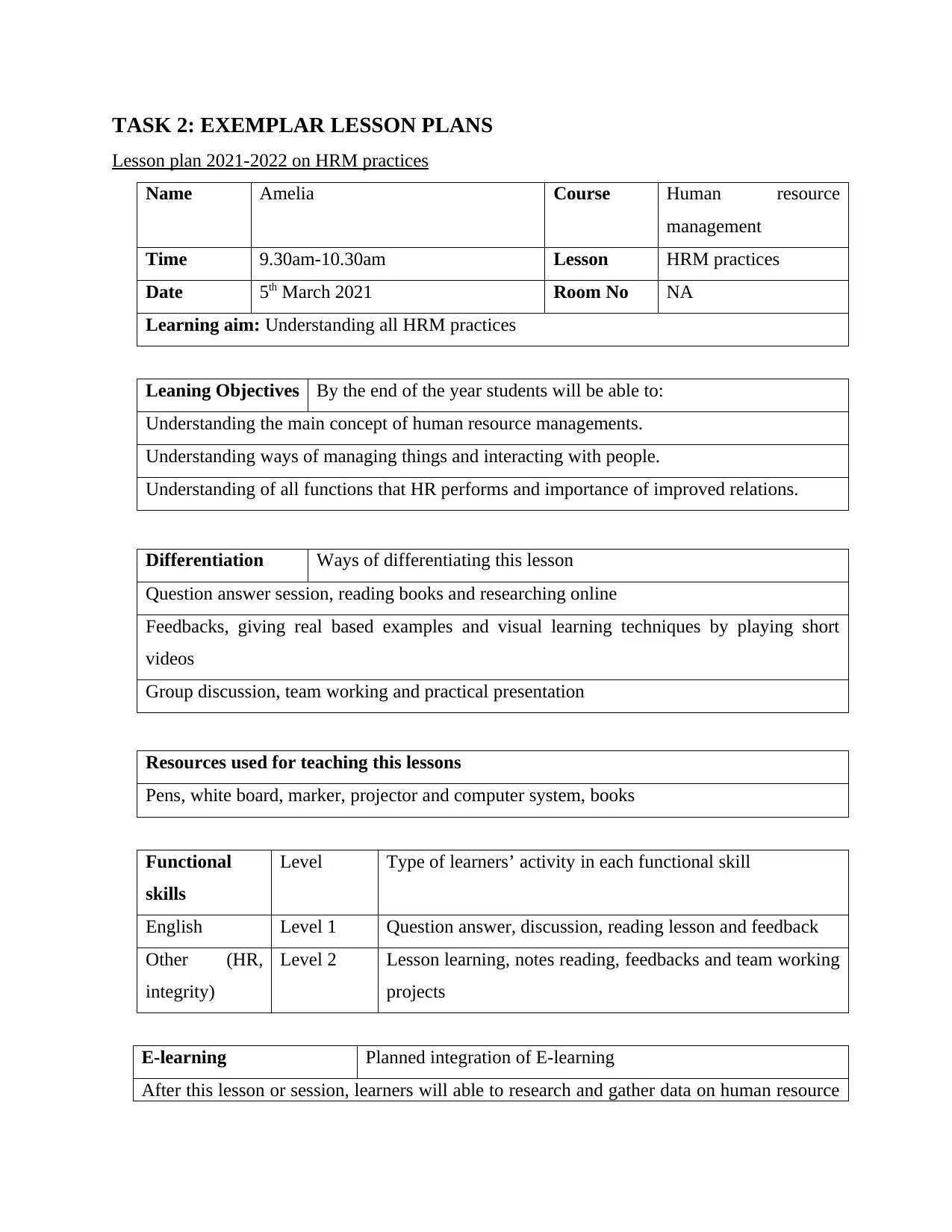
TASK 2: EXEMPLAR LESSON PLANS
Lesson plan 2021-2022 on HRM practices
Name Amelia Course Human resource
management
Time 9.30am-10.30am Lesson HRM practices
Date 5th March 2021 Room No NA
Learning aim: Understanding all HRM practices
Leaning Objectives By the end of the year students will be able to:
Understanding the main concept of human resource managements.
Understanding ways of managing things and interacting with people.
Understanding of all functions that HR performs and importance of improved relations.
Differentiation Ways of differentiating this lesson
Question answer session, reading books and researching online
Feedbacks, giving real based examples and visual learning techniques by playing short
videos
Group discussion, team working and practical presentation
Resources used for teaching this lessons
Pens, white board, marker, projector and computer system, books
Functional
skills
Level Type of learners’ activity in each functional skill
English Level 1 Question answer, discussion, reading lesson and feedback
Other (HR,
integrity)
Level 2 Lesson learning, notes reading, feedbacks and team working
projects
E-learning Planned integration of E-learning
After this lesson or session, learners will able to research and gather data on human resource
Lesson plan 2021-2022 on HRM practices
Name Amelia Course Human resource
management
Time 9.30am-10.30am Lesson HRM practices
Date 5th March 2021 Room No NA
Learning aim: Understanding all HRM practices
Leaning Objectives By the end of the year students will be able to:
Understanding the main concept of human resource managements.
Understanding ways of managing things and interacting with people.
Understanding of all functions that HR performs and importance of improved relations.
Differentiation Ways of differentiating this lesson
Question answer session, reading books and researching online
Feedbacks, giving real based examples and visual learning techniques by playing short
videos
Group discussion, team working and practical presentation
Resources used for teaching this lessons
Pens, white board, marker, projector and computer system, books
Functional
skills
Level Type of learners’ activity in each functional skill
English Level 1 Question answer, discussion, reading lesson and feedback
Other (HR,
integrity)
Level 2 Lesson learning, notes reading, feedbacks and team working
projects
E-learning Planned integration of E-learning
After this lesson or session, learners will able to research and gather data on human resource
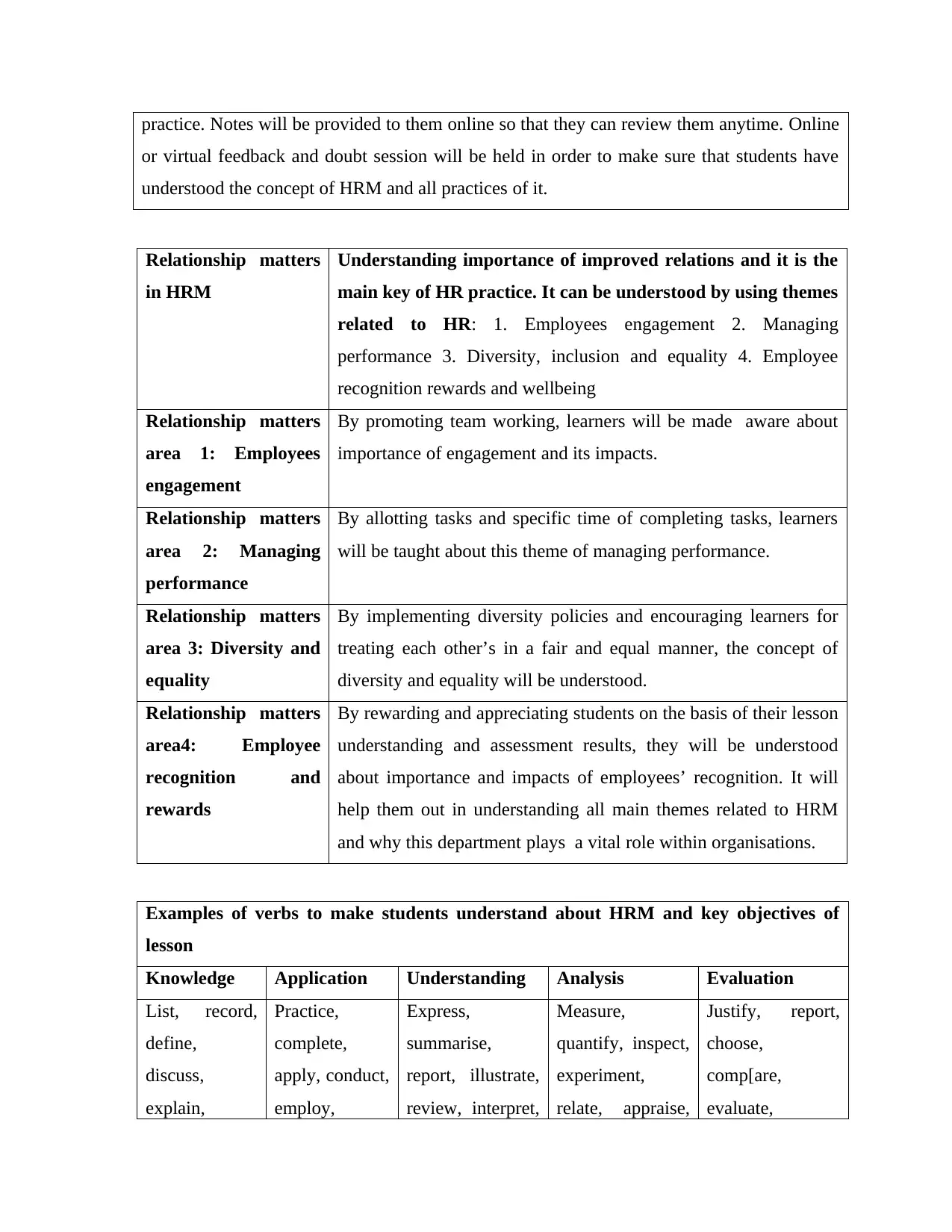
practice. Notes will be provided to them online so that they can review them anytime. Online
or virtual feedback and doubt session will be held in order to make sure that students have
understood the concept of HRM and all practices of it.
Relationship matters
in HRM
Understanding importance of improved relations and it is the
main key of HR practice. It can be understood by using themes
related to HR: 1. Employees engagement 2. Managing
performance 3. Diversity, inclusion and equality 4. Employee
recognition rewards and wellbeing
Relationship matters
area 1: Employees
engagement
By promoting team working, learners will be made aware about
importance of engagement and its impacts.
Relationship matters
area 2: Managing
performance
By allotting tasks and specific time of completing tasks, learners
will be taught about this theme of managing performance.
Relationship matters
area 3: Diversity and
equality
By implementing diversity policies and encouraging learners for
treating each other’s in a fair and equal manner, the concept of
diversity and equality will be understood.
Relationship matters
area4: Employee
recognition and
rewards
By rewarding and appreciating students on the basis of their lesson
understanding and assessment results, they will be understood
about importance and impacts of employees’ recognition. It will
help them out in understanding all main themes related to HRM
and why this department plays a vital role within organisations.
Examples of verbs to make students understand about HRM and key objectives of
lesson
Knowledge Application Understanding Analysis Evaluation
List, record,
define,
discuss,
explain,
Practice,
complete,
apply, conduct,
employ,
Express,
summarise,
report, illustrate,
review, interpret,
Measure,
quantify, inspect,
experiment,
relate, appraise,
Justify, report,
choose,
comp[are,
evaluate,
or virtual feedback and doubt session will be held in order to make sure that students have
understood the concept of HRM and all practices of it.
Relationship matters
in HRM
Understanding importance of improved relations and it is the
main key of HR practice. It can be understood by using themes
related to HR: 1. Employees engagement 2. Managing
performance 3. Diversity, inclusion and equality 4. Employee
recognition rewards and wellbeing
Relationship matters
area 1: Employees
engagement
By promoting team working, learners will be made aware about
importance of engagement and its impacts.
Relationship matters
area 2: Managing
performance
By allotting tasks and specific time of completing tasks, learners
will be taught about this theme of managing performance.
Relationship matters
area 3: Diversity and
equality
By implementing diversity policies and encouraging learners for
treating each other’s in a fair and equal manner, the concept of
diversity and equality will be understood.
Relationship matters
area4: Employee
recognition and
rewards
By rewarding and appreciating students on the basis of their lesson
understanding and assessment results, they will be understood
about importance and impacts of employees’ recognition. It will
help them out in understanding all main themes related to HRM
and why this department plays a vital role within organisations.
Examples of verbs to make students understand about HRM and key objectives of
lesson
Knowledge Application Understanding Analysis Evaluation
List, record,
define,
discuss,
explain,
Practice,
complete,
apply, conduct,
employ,
Express,
summarise,
report, illustrate,
review, interpret,
Measure,
quantify, inspect,
experiment,
relate, appraise,
Justify, report,
choose,
comp[are,
evaluate,
⊘ This is a preview!⊘
Do you want full access?
Subscribe today to unlock all pages.

Trusted by 1+ million students worldwide
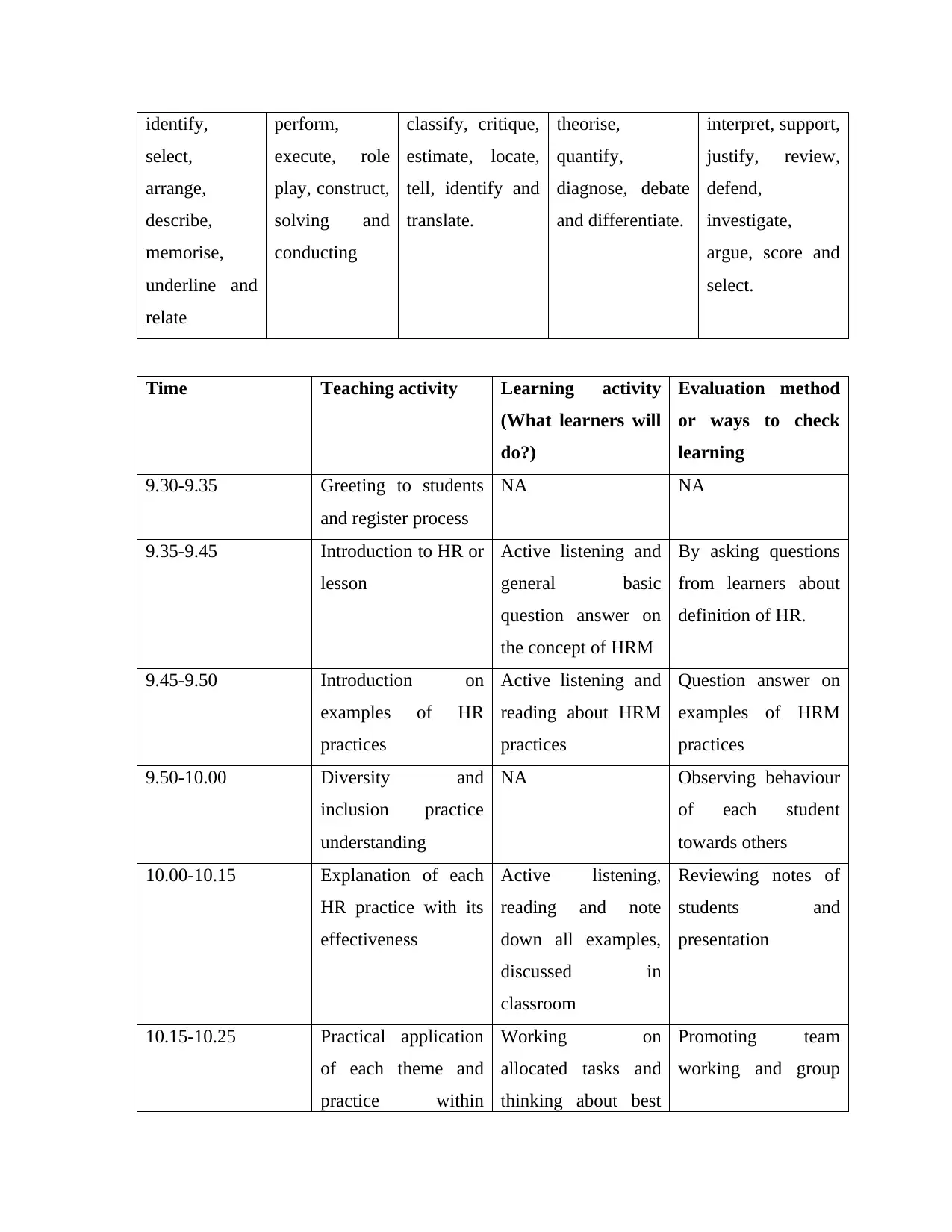
identify,
select,
arrange,
describe,
memorise,
underline and
relate
perform,
execute, role
play, construct,
solving and
conducting
classify, critique,
estimate, locate,
tell, identify and
translate.
theorise,
quantify,
diagnose, debate
and differentiate.
interpret, support,
justify, review,
defend,
investigate,
argue, score and
select.
Time Teaching activity Learning activity
(What learners will
do?)
Evaluation method
or ways to check
learning
9.30-9.35 Greeting to students
and register process
NA NA
9.35-9.45 Introduction to HR or
lesson
Active listening and
general basic
question answer on
the concept of HRM
By asking questions
from learners about
definition of HR.
9.45-9.50 Introduction on
examples of HR
practices
Active listening and
reading about HRM
practices
Question answer on
examples of HRM
practices
9.50-10.00 Diversity and
inclusion practice
understanding
NA Observing behaviour
of each student
towards others
10.00-10.15 Explanation of each
HR practice with its
effectiveness
Active listening,
reading and note
down all examples,
discussed in
classroom
Reviewing notes of
students and
presentation
10.15-10.25 Practical application
of each theme and
practice within
Working on
allocated tasks and
thinking about best
Promoting team
working and group
select,
arrange,
describe,
memorise,
underline and
relate
perform,
execute, role
play, construct,
solving and
conducting
classify, critique,
estimate, locate,
tell, identify and
translate.
theorise,
quantify,
diagnose, debate
and differentiate.
interpret, support,
justify, review,
defend,
investigate,
argue, score and
select.
Time Teaching activity Learning activity
(What learners will
do?)
Evaluation method
or ways to check
learning
9.30-9.35 Greeting to students
and register process
NA NA
9.35-9.45 Introduction to HR or
lesson
Active listening and
general basic
question answer on
the concept of HRM
By asking questions
from learners about
definition of HR.
9.45-9.50 Introduction on
examples of HR
practices
Active listening and
reading about HRM
practices
Question answer on
examples of HRM
practices
9.50-10.00 Diversity and
inclusion practice
understanding
NA Observing behaviour
of each student
towards others
10.00-10.15 Explanation of each
HR practice with its
effectiveness
Active listening,
reading and note
down all examples,
discussed in
classroom
Reviewing notes of
students and
presentation
10.15-10.25 Practical application
of each theme and
practice within
Working on
allocated tasks and
thinking about best
Promoting team
working and group
Paraphrase This Document
Need a fresh take? Get an instant paraphrase of this document with our AI Paraphraser
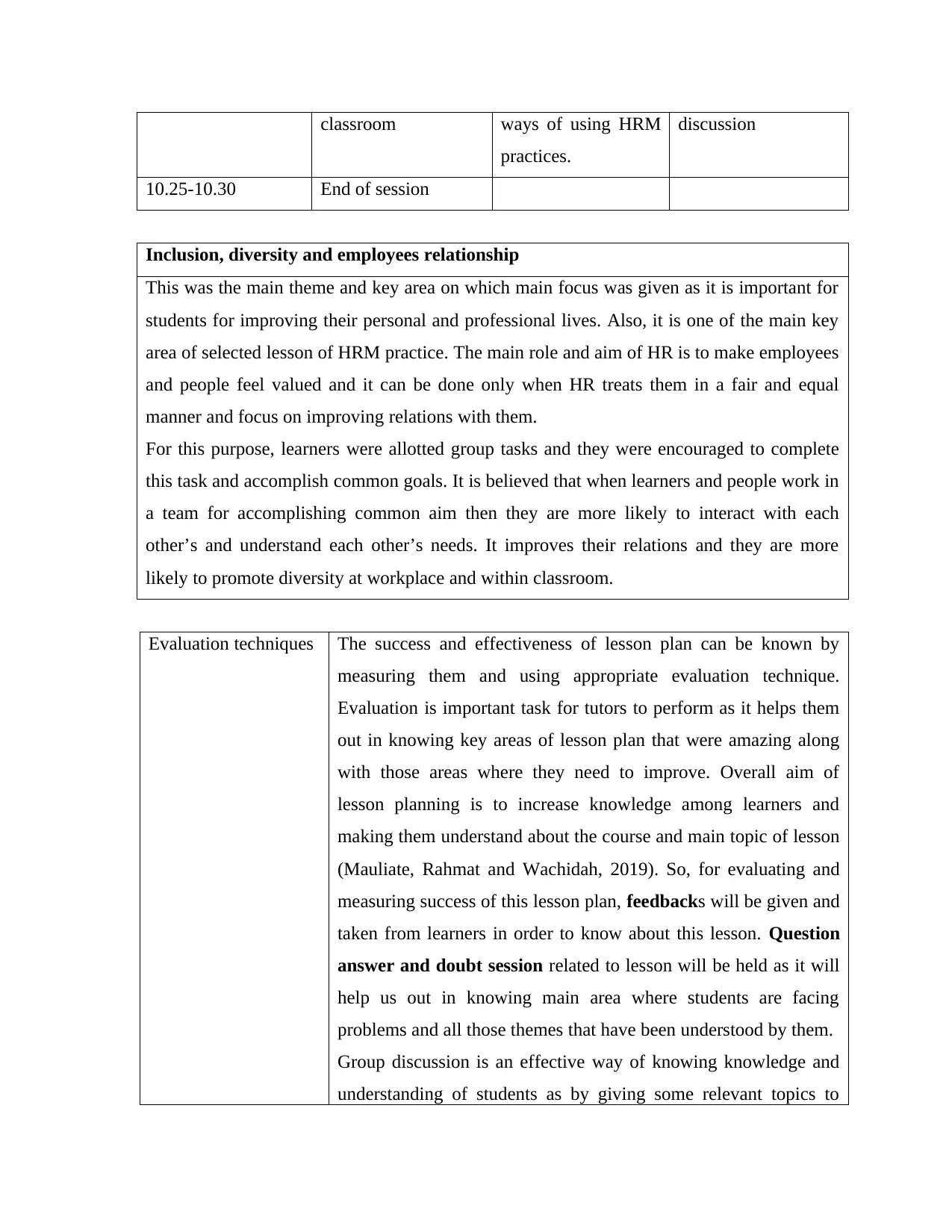
classroom ways of using HRM
practices.
discussion
10.25-10.30 End of session
Inclusion, diversity and employees relationship
This was the main theme and key area on which main focus was given as it is important for
students for improving their personal and professional lives. Also, it is one of the main key
area of selected lesson of HRM practice. The main role and aim of HR is to make employees
and people feel valued and it can be done only when HR treats them in a fair and equal
manner and focus on improving relations with them.
For this purpose, learners were allotted group tasks and they were encouraged to complete
this task and accomplish common goals. It is believed that when learners and people work in
a team for accomplishing common aim then they are more likely to interact with each
other’s and understand each other’s needs. It improves their relations and they are more
likely to promote diversity at workplace and within classroom.
Evaluation techniques The success and effectiveness of lesson plan can be known by
measuring them and using appropriate evaluation technique.
Evaluation is important task for tutors to perform as it helps them
out in knowing key areas of lesson plan that were amazing along
with those areas where they need to improve. Overall aim of
lesson planning is to increase knowledge among learners and
making them understand about the course and main topic of lesson
(Mauliate, Rahmat and Wachidah, 2019). So, for evaluating and
measuring success of this lesson plan, feedbacks will be given and
taken from learners in order to know about this lesson. Question
answer and doubt session related to lesson will be held as it will
help us out in knowing main area where students are facing
problems and all those themes that have been understood by them.
Group discussion is an effective way of knowing knowledge and
understanding of students as by giving some relevant topics to
practices.
discussion
10.25-10.30 End of session
Inclusion, diversity and employees relationship
This was the main theme and key area on which main focus was given as it is important for
students for improving their personal and professional lives. Also, it is one of the main key
area of selected lesson of HRM practice. The main role and aim of HR is to make employees
and people feel valued and it can be done only when HR treats them in a fair and equal
manner and focus on improving relations with them.
For this purpose, learners were allotted group tasks and they were encouraged to complete
this task and accomplish common goals. It is believed that when learners and people work in
a team for accomplishing common aim then they are more likely to interact with each
other’s and understand each other’s needs. It improves their relations and they are more
likely to promote diversity at workplace and within classroom.
Evaluation techniques The success and effectiveness of lesson plan can be known by
measuring them and using appropriate evaluation technique.
Evaluation is important task for tutors to perform as it helps them
out in knowing key areas of lesson plan that were amazing along
with those areas where they need to improve. Overall aim of
lesson planning is to increase knowledge among learners and
making them understand about the course and main topic of lesson
(Mauliate, Rahmat and Wachidah, 2019). So, for evaluating and
measuring success of this lesson plan, feedbacks will be given and
taken from learners in order to know about this lesson. Question
answer and doubt session related to lesson will be held as it will
help us out in knowing main area where students are facing
problems and all those themes that have been understood by them.
Group discussion is an effective way of knowing knowledge and
understanding of students as by giving some relevant topics to
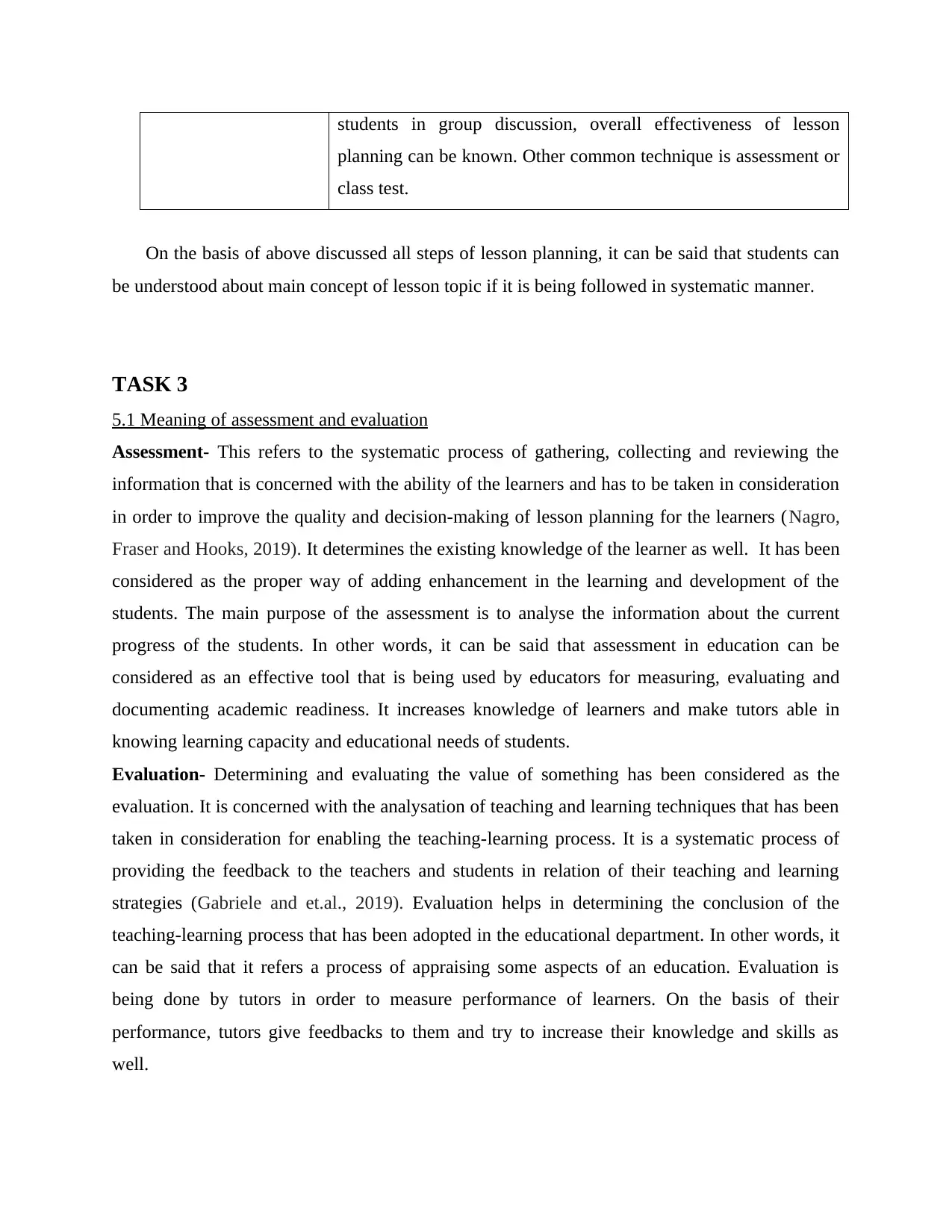
students in group discussion, overall effectiveness of lesson
planning can be known. Other common technique is assessment or
class test.
On the basis of above discussed all steps of lesson planning, it can be said that students can
be understood about main concept of lesson topic if it is being followed in systematic manner.
TASK 3
5.1 Meaning of assessment and evaluation
Assessment- This refers to the systematic process of gathering, collecting and reviewing the
information that is concerned with the ability of the learners and has to be taken in consideration
in order to improve the quality and decision-making of lesson planning for the learners (Nagro,
Fraser and Hooks, 2019). It determines the existing knowledge of the learner as well. It has been
considered as the proper way of adding enhancement in the learning and development of the
students. The main purpose of the assessment is to analyse the information about the current
progress of the students. In other words, it can be said that assessment in education can be
considered as an effective tool that is being used by educators for measuring, evaluating and
documenting academic readiness. It increases knowledge of learners and make tutors able in
knowing learning capacity and educational needs of students.
Evaluation- Determining and evaluating the value of something has been considered as the
evaluation. It is concerned with the analysation of teaching and learning techniques that has been
taken in consideration for enabling the teaching-learning process. It is a systematic process of
providing the feedback to the teachers and students in relation of their teaching and learning
strategies (Gabriele and et.al., 2019). Evaluation helps in determining the conclusion of the
teaching-learning process that has been adopted in the educational department. In other words, it
can be said that it refers a process of appraising some aspects of an education. Evaluation is
being done by tutors in order to measure performance of learners. On the basis of their
performance, tutors give feedbacks to them and try to increase their knowledge and skills as
well.
planning can be known. Other common technique is assessment or
class test.
On the basis of above discussed all steps of lesson planning, it can be said that students can
be understood about main concept of lesson topic if it is being followed in systematic manner.
TASK 3
5.1 Meaning of assessment and evaluation
Assessment- This refers to the systematic process of gathering, collecting and reviewing the
information that is concerned with the ability of the learners and has to be taken in consideration
in order to improve the quality and decision-making of lesson planning for the learners (Nagro,
Fraser and Hooks, 2019). It determines the existing knowledge of the learner as well. It has been
considered as the proper way of adding enhancement in the learning and development of the
students. The main purpose of the assessment is to analyse the information about the current
progress of the students. In other words, it can be said that assessment in education can be
considered as an effective tool that is being used by educators for measuring, evaluating and
documenting academic readiness. It increases knowledge of learners and make tutors able in
knowing learning capacity and educational needs of students.
Evaluation- Determining and evaluating the value of something has been considered as the
evaluation. It is concerned with the analysation of teaching and learning techniques that has been
taken in consideration for enabling the teaching-learning process. It is a systematic process of
providing the feedback to the teachers and students in relation of their teaching and learning
strategies (Gabriele and et.al., 2019). Evaluation helps in determining the conclusion of the
teaching-learning process that has been adopted in the educational department. In other words, it
can be said that it refers a process of appraising some aspects of an education. Evaluation is
being done by tutors in order to measure performance of learners. On the basis of their
performance, tutors give feedbacks to them and try to increase their knowledge and skills as
well.
⊘ This is a preview!⊘
Do you want full access?
Subscribe today to unlock all pages.

Trusted by 1+ million students worldwide
1 out of 18
Related Documents
Your All-in-One AI-Powered Toolkit for Academic Success.
+13062052269
info@desklib.com
Available 24*7 on WhatsApp / Email
![[object Object]](/_next/static/media/star-bottom.7253800d.svg)
Unlock your academic potential
Copyright © 2020–2025 A2Z Services. All Rights Reserved. Developed and managed by ZUCOL.




